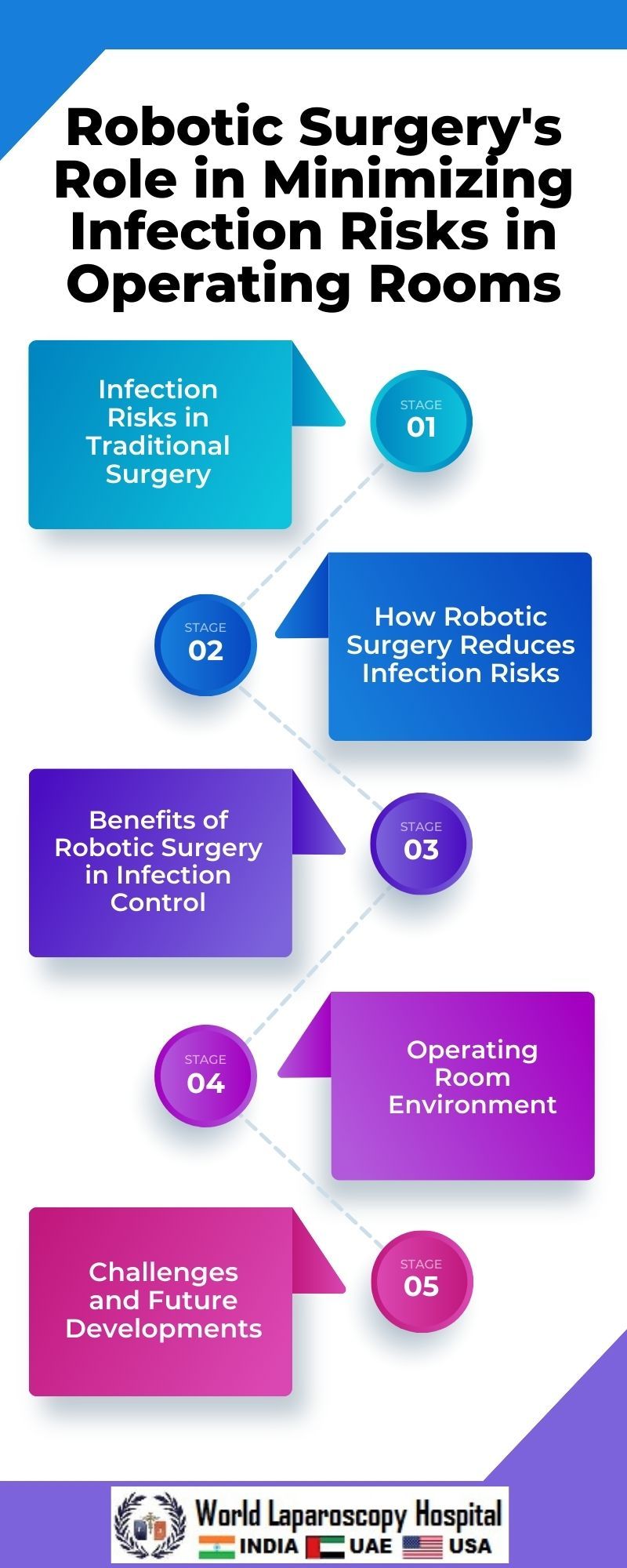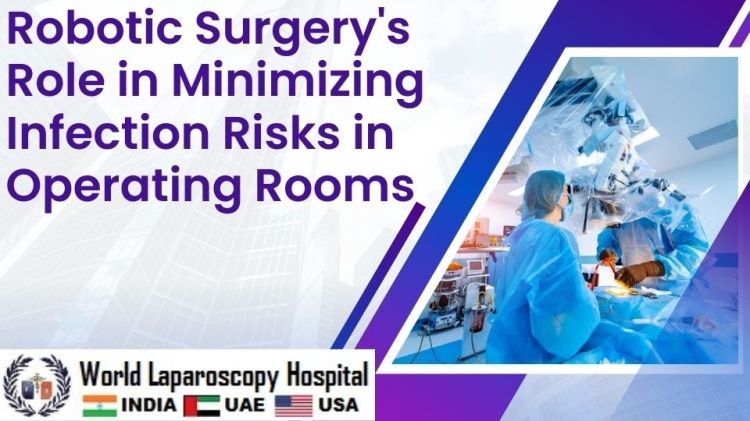Robotic Surgery's Role in Minimizing Infection Risks in Operating Rooms
Introduction
In the ever-evolving landscape of medical advancements, robotic surgery stands out as a transformative force, particularly in its ability to mitigate infection risks in operating rooms. As the healthcare industry continues to prioritize patient safety and innovative solutions, robotic surgery has emerged as a game-changer in enhancing surgical precision while minimizing the potential for infections. This article delves into the multifaceted ways in which robotic surgery contributes to creating sterile environments and ultimately revolutionizes the field of surgery.

Robotic surgery, also known as robot-assisted surgery, originated from the need to overcome the limitations of traditional surgical techniques. The first documented use of a robotic system in surgery occurred in 1985 when the PUMA 560 robotic surgical arm assisted in a neurosurgical biopsy. Over the years, technological advancements paved the way for more sophisticated and versatile robotic systems.
The da Vinci Surgical System, introduced in the late 1990s, marked a significant milestone. This robotic platform, developed by Intuitive Surgical, enabled surgeons to perform minimally invasive procedures with enhanced precision and control. Since then, robotic surgery has rapidly evolved, becoming a staple in various medical specialties, including urology, gynecology, and general surgery.
How Robotic Surgery WorksRobotic surgery involves the use of robotic systems to assist surgeons in performing intricate procedures with greater accuracy and dexterity. The da Vinci Surgical System, a widely adopted platform, consists of a console, robotic arms, and a 3D vision system.
Surgeons sit at the console, which provides a magnified, high-definition, 3D view of the surgical site. The robotic arms are equipped with specialized instruments that mimic the surgeon's hand movements with precision. These instruments are inserted into the patient's body through small incisions, allowing for minimally invasive surgery.
The 3D vision system provides depth perception, enhancing the surgeon's ability to navigate complex anatomical structures. The combination of these elements empowers surgeons to perform intricate procedures with smaller incisions, reduced blood loss, and faster recovery times for patients.
Minimizing Human Contact, Maximizing SterilityOne of the key advantages of robotic surgery in minimizing infection risks lies in its ability to reduce human contact in the operating room. In traditional open surgeries, the surgical team is in close proximity to the patient, creating opportunities for contamination. Robotic surgery, however, limits the number of personnel directly interacting with the patient.
The surgeon's console, situated away from the operating table, allows for a more controlled and sterile environment. The robotic arms, operated by the console, perform the intricate maneuvers, minimizing the need for additional hands in the surgical field. This reduction in human contact decreases the risk of introducing pathogens into the surgical site, lowering the overall infection risk for patients.
Precision and Control: Reducing Tissue TraumaRobotic surgery's emphasis on precision and control contributes significantly to minimizing tissue trauma during procedures. Traditional open surgeries often involve larger incisions, leading to more extensive tissue damage and a higher risk of infections. In contrast, robotic systems enable surgeons to make smaller, more precise incisions.
The articulating instruments at the end of the robotic arms allow for delicate and controlled movements, minimizing collateral damage to surrounding tissues. The enhanced visualization provided by the 3D vision system further ensures that surgeons can navigate through complex anatomical structures with unparalleled accuracy. The result is a reduction in tissue trauma, blood loss, and postoperative pain, creating an environment conducive to faster healing and a lower risk of infections.
Speeding Up Recovery TimesRobotic surgery's impact on infection risks extends to the postoperative phase, with its ability to expedite recovery times. Minimally invasive procedures facilitated by robotic systems often lead to shorter hospital stays and quicker return to normal activities for patients. Reduced hospitalization periods inherently lower the risk of healthcare-associated infections, as patients spend less time exposed to potential pathogens in medical settings.
Moreover, the smaller incisions and diminished tissue trauma associated with robotic surgery contribute to faster healing. Patients experience less pain and discomfort, enabling them to resume regular activities sooner than those undergoing traditional open surgeries. The shortened recovery times associated with robotic surgery play a pivotal role in minimizing the overall infection risk and improving patient outcomes.
Telesurgery: Redefining Surgical AccessibilityThe integration of telecommunication technologies in robotic surgery has given rise to the concept of telesurgery, allowing surgeons to perform procedures remotely. While not yet widely adopted due to technological and regulatory challenges, the potential impact of telesurgery on infection risks is substantial.
Telesurgery allows expert surgeons to conduct procedures from a distant location, reducing the need for travel and physical presence in the operating room. This not only enhances access to specialized surgical expertise but also minimizes the number of individuals in the operating room, further decreasing the risk of infections. As telesurgery continues to advance, it holds the promise of revolutionizing surgical practices and infection control strategies.
Challenges and ConsiderationsDespite the numerous benefits of robotic surgery in minimizing infection risks, it is essential to acknowledge and address certain challenges associated with this technology. Cost remains a significant barrier to widespread adoption, with robotic systems requiring substantial financial investments for acquisition and maintenance. Training healthcare professionals to operate robotic systems effectively is another challenge, as proficiency in robotic surgery demands a unique skill set.
Additionally, concerns regarding the potential loss of the tactile feedback experienced in traditional surgeries have been raised. While robotic systems provide visual and auditory feedback, replicating the sense of touch remains a technological hurdle. Surgeons must adapt to relying on visual cues and haptic feedback from the robotic system to navigate and manipulate tissues.
Regulatory frameworks and standardization in robotic surgery also require ongoing attention. Ensuring consistent safety protocols, accreditation processes, and guidelines for robotic procedures are crucial for maintaining the highest standards of patient care and infection prevention.
Conclusion
Robotic surgery has emerged as a transformative force in the realm of surgery, offering a myriad of benefits, including the significant reduction of infection risks in operating rooms. By minimizing human contact, enhancing precision, and expediting recovery times, robotic surgery contributes to creating a safer and more efficient surgical environment.
As technology continues to advance and barriers to adoption are addressed, the integration of robotic surgery into mainstream medical practices holds the potential to redefine the future of surgery. The ongoing commitment to research, training, and regulatory oversight will be essential in unlocking the full potential of robotic surgery and ensuring its continued role in minimizing infection risks for patients undergoing surgical procedures.






